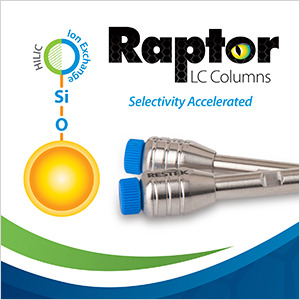
Poor retention, low response, complex sample preparation procedures…the analysis of polar compounds has historically posed challenges to both data quality and lab productivity. Now, Raptor Polar X columns—with their novel phase chemistry that blends HILIC and ion-exchange retention on a single ligand—significantly simplify the analysis of these difficult and varied compounds. And, by bonding that unique ligand to superficially porous particles (SPP), Restek has created a phase that retains and efficiently separates a wide variety of polar compounds.
The Polar X Column has an unparalleled ability to analyse a wide variety of polar compounds, providing a powerful, productive, and versatile tool for LC scientists to use across multiple applications, including:
PFAS
Ultra-short-chain PFAS are often found in environmental waters and include trifluoroacetic acid (TFA), which is the most abundant and one of the most difficult PFAS to analyze.
The critical aspect of TFA analysis is limited retention and/or poor chromatographic performance on reversed-phase and HILIC columns. Raptor Polar X columns enable reliable retention and analysis of TFA due to the presence of a single hybrid ligand.
Polar Pesticides
Direct analysis of polar pesticides, such as glyphosate, its main metabolite (AMPA) and glufosinate, is difficult because these substances are not optimally retained on reversed-phase columns, and chelation with metal surfaces in an LC-MS/MS can significantly reduce the response. Derivatization or ion-pair reagents improve analysis performance, but these can be incompatible with the analysis instrument and require more time for sample preparation. The Raptor Polar X column is a better alternative because its stationary phase has an affinity for polar anionic compounds, such as glyphosate, while offering good retention and efficient elution.
Non-derivatized amino acids
Amino acids are a diverse group of very polar compounds commonly analyzed in reversed-phase or ion-exchange chromatography using pre- or post-column derivatization.
Direct analysis of non-derivatized amino acids often results in limited retention and poor chromatographic performance. The Raptor Polar X column lets you easily retain and separate all non-derivatized amino acids with both non-polar and polar side chains, both positively and negatively charged, in a single method.
The Raptor Polar X stationary phase is specifically designed to selectively retain polar analytes through a balance of two retention mechanisms. This unique hybrid phase is ideal for analysing a wide variety of polar compounds, especially when coupled with mass spectrometry.




